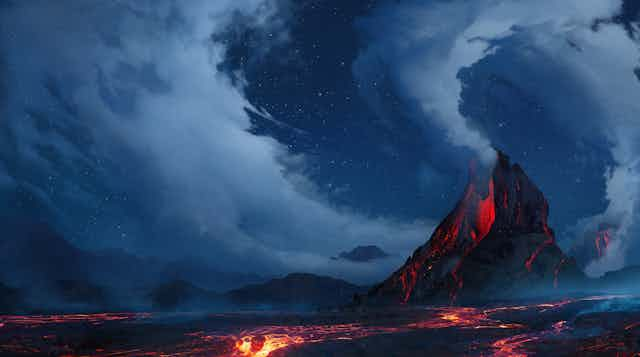The dinosaurs may have volcanoes to thank for their domination of the planet, at least according to one theory. Most scientists think that a severe bout of volcanic activity 200m years ago may have led to the mass extinction that cleared the way for the dinosaurs’ rise. Now we – with a team of colleagues – have discovered new evidence that strengthens this idea: a global geological “fingerprint” indicating volcanic gases were affecting the whole world at the time of the extinction.
Geologists have previously discovered that the Earth’s crust hosts massive amounts of volcanic rock from the end of the Triassic period, 200m years ago. We know from the fossil record that, at about the same time, a very large proportion of Earth’s species died out, which made space for the remaining dinosaurs (and other species) to flourish. As volcanoes can produce large amounts of carbon dioxide (CO2), it’s possible that the volcanic activity that left these massive lava flows behind also provoked global climate change that led to this mass extinction.
What was missing was evidence that the volcanic activity really had such a worldwide impact. By examining geological records from all over the world, we discovered that large amounts of mercury were released into the atmosphere at around the same time as the extinction. As mercury is also released by volcanoes, this suggests the volcanic eruptions really were severe enough to affect the whole world and potentially cause the mass extinction.

The volcanic rocks cover a huge area, across four present-day continents. They are the remains of a huge episode of heightened volcanic activity that lasted about a million years known as the Central Atlantic Magmatic Province (CAMP).
Previous studies have shown that this volcanism might have occurred in pulses. But we didn’t know how the timing and frequency of these emissions compared to the timing of the extinction event and the subsequent recovery of life. Or whether the volcanoes had a worldwide effect. So we decided to look for a “fingerprint” of the eruptions in the same kind of sediments that record the mass extinction.
Mercury marker
Modern volcanoes emit a large number of gases, most famously sulphur dioxide and CO2, but also trace quantities of the metal mercury. This mercury can stay in the atmosphere for between six months and two years and that means it can be distributed around the world before eventually being deposited in sediments at the bottom of lakes, rivers, and seas.
These same sediments record evidence of bouts of climate change and mass extinction. So, if a sediment layer that records a mass extinction also features unusually high mercury concentrations, we can deduce that volcanic activity likely coincided with (and maybe caused) that extinction.
Working with colleagues from the universities of Exeter and Southampton, we investigated six sedimentary records of the end-Triassic extinction for mercury concentrations. These records were from the UK, Austria, Argentina, Greenland, Canada and Morocco. This spread over four continents and both hemispheres gave us global insight into the impact of volcanic gas emissions during the end-Triassic mass extinction.

Volcanic link
We found that five of the six records showed a large increase in mercury content beginning at the end of the Triassic period, with a distinct spike in mercury at the layer corresponding to the extinction itself. The extinction layer in the Morocco sample also overlaps with the volcanic rocks from the CAMP. This meant we could tie this large emission of mercury into the global atmosphere to a specific volcanic event, even though the eruption was around 200m years ago.
What’s more, this evidence reinforces the conclusion that mercury spikes found elsewhere in the geological record were caused by volcanic activity. We found other mercury peaks between the extinction layer and the layer that marked the start of the Jurassic period, which occurred approximately 100,000 to 200,000 years later. This suggests that multiple episodes of tremendous volcanic activity took place during and immediately after the end-Triassic extinction.
More importantly, we were able to show the elevated mercury emissions matched previously established increases in the amount of CO2 in the atmosphere. This strongly supports the theory that the CO2 emissions thought to cause the end-Triassic extinction came from volcanoes.
This link between increased atmospheric mercury and CO2 at the same time as the end-Triassic extinction offers fundamental insights into some of the factors governing the evolution of life on our planet. And, from a geological point of view, it highlights the potential of mercury to help explain other extinction events in Earth’s history.

